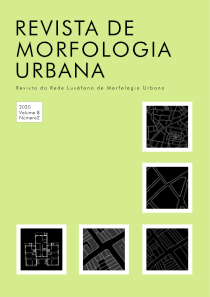Abstract
This research offers an assessment of the urban form and social fabric of Azevedo, in the parish of Campanhã, Porto, Portugal, with the objective of verifying if the weaknesses of the urban form correspond to the weaknesses of the social fabric and of the interpretation/representation held by the residents of this place. The analysis of the physical form is based on the Morpho methodology, considering six criteria related to the degree of urbanity of the area: (i) accessibility of streets; (ii) dimensions of street-blocks; (iii) density of plots; (iv) alignment of buildings; (v) buildings age, and (vi) building use. The social basis is analysed through a quantitative mapping elaborated from statistic data, considering social exclusion. The mapping of the residents’ representations is made through statements collected in the field. The results indicate correspondence between areas of urban configuration with more weaknesses and social groups that are more exposed to social exclusion, but the link with inclusion is not so straightforward. On the other hand, research has shown that there was a strong correspondence between the weaknesses of the physical form and the symbolic representations of the place.
References
Azevedo, J. e Baptista, I (Coords.) (2010) Porto Solidário: diagnóstico social do Porto. Porto, Universidade Católica Portuguesa. Disponível em: https://jpn.up.pt/pdf/Porto_Social_diagnostico_final.pdf. [Consultado em: 12 de março de 2020].
Bertoni, L. M., Galinkin, A. L. (2017) Teoria e métodos em representações sociais. Em: Mororó, L. P.; Couto, M. E. S. e Assis, R. A. M. (Orgs.) Notas teórico-metodológicas de pesquisas em educação: concepções e trajetórias [online]. Ilhéus, Editus, pp. 101-122. Disponível em: https://doi.org/10.7476/9788574554938.005.
Bourdieu, P. (1997) Efeitos do lugar. Em: Bourdieu, P. (Org.) A miséria do mundo. Petrópolis, Vozes, pp. 159-175.
CMP, Câmara Municipal do Porto (2019) Projeto de Delimitação da Área de Recuperação Urbana de Azevedo. Disponível em: https://balcaovirtual.cm-porto.pt/PT/cidadaos/guiatematico/PlaneamentoOrdenamento/AreasReabilitacaoUrbanaARU/. [Consultado em: 10 de dezembro de 2020].
Centro de Estudos e Mapeamento da Exclusão Social para Políticas Públicas (2014) Atlas da Inclusão/Exclusão Social no interior paulista 2000 – 2010: Mapeando e interpretando desigualdades territoriais urbanas: Conhecimentos e tecnologias para políticas públicas. Volume 1. Presidente Prudente, Faculdade de Ciencias e Tecnologia da Unesp. Disponível em: https://www.dropbox.com/s/tmb1g4zesxj9zmz/Atlas%20Parte%201.pdf?dl=0. [Consultado em: 18 de março de 2020].
Duany, A. (2002) Introduction to the special issue: the transect. Journal of Urban Design, 7, 251-60.
Hillier B. e Hanson, J. (1984) The social logic of space. Cambridge, Cambridge University Press.
Hillier, B. et al. (1993) Natural movement: or, configuration and attraction in urban pedestrian movement. Environment and Planning B, 20 (1), 29-66, 1993.
Hillier, B. (1996) Space is the machine. Cambridge, Cambridge University Press,
Holanda, F. (2012) Urbanidade: arquitetônica e social. Em: Aguiar, D. e Netto, V. (Orgs.) Urbanidades. Rio de Janeiro, Folio Digital, Letra e Imagem, pp. 163-188.
Jacobs, J. (2014) Morte e vida das grandes cidades. 3ª ed. São Paulo, Martins Fontes.
Kropf, K. (2017) Handbook of urban morphology. London, Wiley.
Lees, L. (2010) Planning Urbanity? Environment and Planning A, 42, 2302-2308. Disponível em: https://doi.org/10.1068/a43360.
Lynch, K. (1990) A imagem da cidade. Lisboa, Edições 70.
Marcus, L. (2010) Spatial Capital: a proposal for na extension of space syntax into a more general urban morphology. The Journal of Space Syntax, 1, 30-40. Disponívl em: http://www.journalofspacesyntax.org/. [Consultado em: 15 de outubro de 2019].
Netto, V., Vargas, J. e Saboya, R. (2012) (Buscando) os efeitos sociais da morfologia arquitetônica. Urbe. Revista Brasileira de Gestão Urbana, 4 (2), 261-282. Disponível em: https://doi.org/10.7213/urbe.7400.
Observatório Nacional da Luta Contra a Pobreza (2018) Pobreza e exclusão social em Portugal – 2016-2017. Relatório. Disponível em: file:///C:/Users/Utilizador/Downloads/Pobreza-e-Exclus%C3%A3o-Social-em-Portugal-2016-2017.pdf. [Consultado em: 10 de março de 2020].
Oliveira, V. (2013) Morpho, a metodology for assessing urban form. Urban Morphology, 17 [1], 149-161.
Oliveira, V. (2016a) Forma e paisagem urbana de Lisboa. Paisagem e Ambiente: ensaios, 38, 13-32. Disponível em: http://DX.DOI.ORG/10.11606/ISSN.2359-5361.V0I38P13-32.
Oliveira, V. (2016b) Urban Morphology: An Introduction to the Study of the Physical Form of Cities. Cham, Springer.
Oliveira, V. e Medeiros, V. (2016) Morpho: Combining morphological measures. Environment and Planning B: Planning and Design, 43, 1-21. Disponível em: https://doi.org/10.1177/0265813515596529.
Oliveira, V. e Silva, M. (2013) Morpho: investigação morfológica e prática de planejamento. Revista de Morfologia Urbana, 1, 31-44. Disponível em: http://revistademorfologiaurbana.org/index.php/rmu/article/view/33/27. [Consultado em 10 de abril de 2019].
Perista, P. e Baptista, I. (2010) A estruturalidade da pobreza e da exclusão social na sociedade portuguesa – conceitos, dinâmicas e desafios para a acção. Forum Sociológico, 20, 39-46. Disponível em: https://forumsociologico.fcsh.unl.pt/PDF/FS20_4artigo.pdf. [Consultado em 14 de março de 2020].
Remali, A.M. and Porta, S. (2017) Street networks and street-blocks in the city centre of Tripoli, Urban Morphology 21(2), pp. 161-179.
Siksna, A. (1997) The effects of block size and form in North American and Australian city centers. Urban Morphology, 1, 19-33.
Talen, E. (2018) The relentless link between neighbourhoods and segregation: what are the alternatives? Town Planning Review, 89(5), pp. 443-462.
Ye, Y., Li, D. and Liu, X. (2018) How block density and typology affect urban vitality: an exploratory analysis in Shenzhen, China, Urban Geography, 39(4), pp. 631-652.

This work is licensed under a Creative Commons Attribution 4.0 International License.
Copyright (c) 2020 Arlete Francisco, Vitor Oliveira


